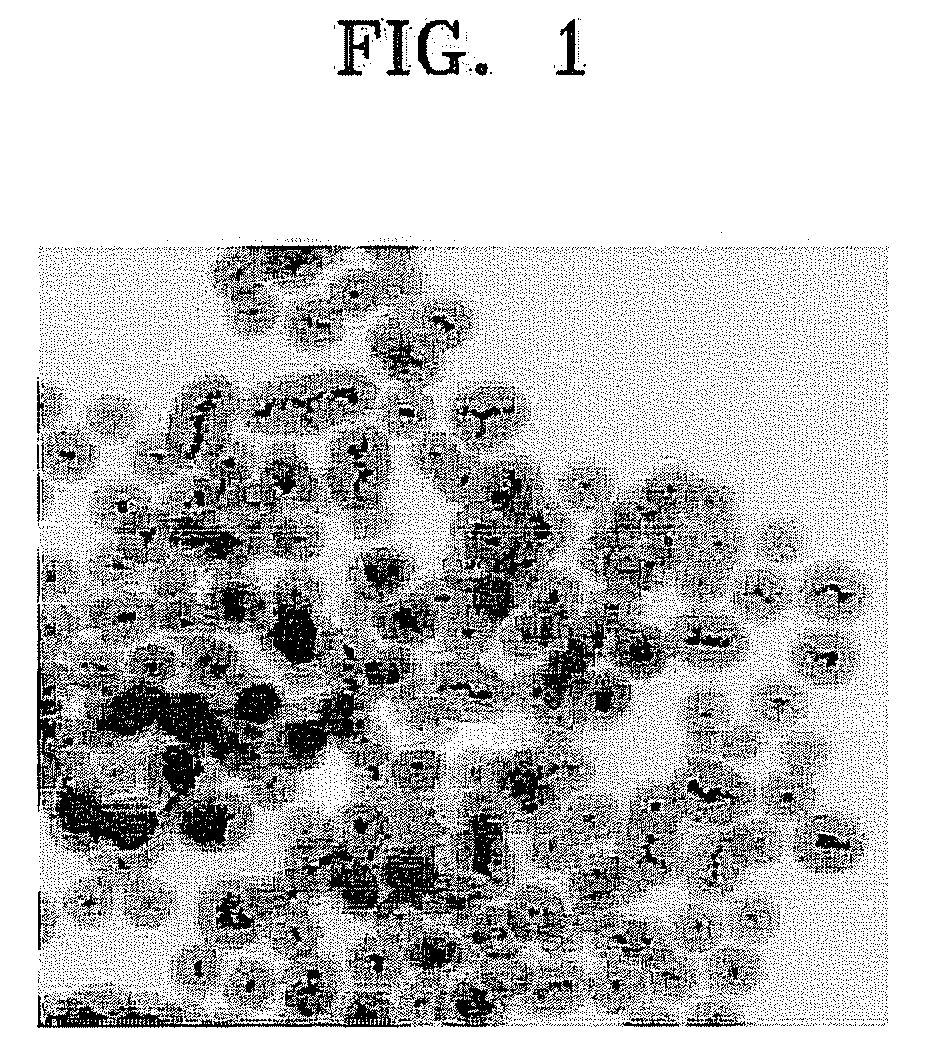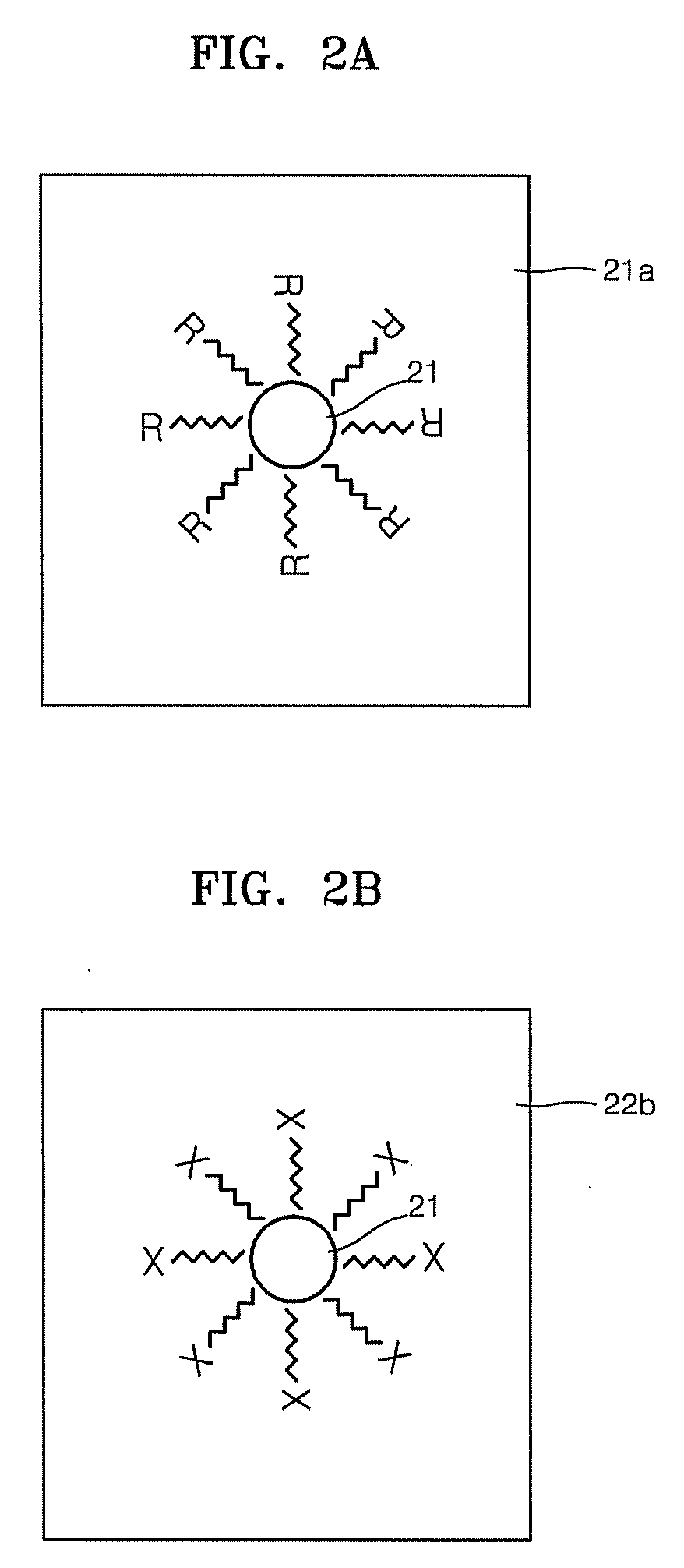Method of coating nanoparticles
a nanoparticle and metal oxide technology, applied in the field of metal oxide coating nanoparticles, can solve the problems of difficult uniform coating of nanoparticles, difficult transfer of nanoparticles coated with hydrophobic surfactant to the cores of micelles,
- Summary
- Abstract
- Description
- Claims
- Application Information
AI Technical Summary
Benefits of technology
Problems solved by technology
Method used
Image
Examples
example 1
Process for Manufacturing Cyclohexane, Pyridine, and Butanol Solutions of CdSeS Nanoparticles
[0050] 16 grams (g) trioctylamine (TOA), 0.5 g oleic acid, and 0.4 millimoles (mmol) cadmium oxide were poured into a 125 milliliter (ml) flask in which a reflux condenser was installed; and the mixture was stirred at a temperature of 300 degrees Celsius (° C.) to prepare a clean reaction mixture. Separately, Se powder was dissolved in trioctyphosphine (TOP) to prepare an Se-TOP complex solution having a concentration of about 0.25 moles of solute per liter of solvent (M), and S powder was dissolved in TOP to prepare an S-TOP complex solution having a concentration of about 1.0 M. A mixture of 0.9 ml of the S-TOP complex solution and 0.1 ml of the Se-TOP complex solution was rapidly injected into the reaction mixture including cadmium, and the reaction mixture was further stirred for about 4 minutes. After reaction, the reaction mixture was rapidly cooled. Next, ethanol (non-solvent) was ad...
example 2
Process for Coating SiO2 on CdSeS Nanoparticles by Using Pyridine Solution
[0052] 0.1 g IGEPAL CO-520 was added to 2 ml cyclohexane, and the mixture was stirred at room temperature for about 30 minutes to obtain an IGEPAL CO-520 / cyclohexane solution. 40 microliters (μl) of the 1 wt % pyridine solution of CdSeS nanoparticles manufactured according to Example 1 were added to the IGEPAL CO-520 / cyclohexane solution, and then the mixed solution was stirred at room temperature for about 30 minutes. Next, a 50 μl NH4OH solution was added to the mixture and then the solution was stirred again at room temperature for about 1 hour. 10-μl tetraethylorthosilicate (TEOS) was added to the solution, and the solution was stirred at room temperature for about 24 hours. After stirring, methanol was added to the solution, and the solution was centrifuged. The precipitate of the centrifuged solution was dispersed in ethanol. FIG. 4A is an emission spectrum excited at 365 nm of the SiO2-coated CdSeS nan...
example 3
Process for Coating SiO2 on CdSeS Nanoparticles by Using Butanol Solution
[0053] 0.1 g IGEPAL CO-520 was added to 2 ml cyclohexane, and the mixture was stirred at room temperature for 30 minutes to obtain an IGEPAL Co-520 / cyclohexane solution. 40 μl of the 1 wt % butanol solution of CdSeS nanoparticies manufactured according to Example 1 were added to the IGEPAL Co-520 / cyclohexane solution, and the mixture was stirred at room temperature for 30 minutes. Next, a 50 82 l NH4OH solution was added to the mixture, and the mixture was further stirred at room temperature for 1 hour. Next, 10 μl TEOS was added to the mixture, and the mixture was stirred at room temperature for 24 hours. After that, methanol was added to the mixture, and the mixture was centrifuged. The precipitate of the centrifuged mixture was dispersed in ethanol. FIG. 5A is an electron microscope image of the SiO2-coated CdSeS nanoparticles.
PUM
| Property | Measurement | Unit |
|---|---|---|
| thickness | aaaaa | aaaaa |
| temperature | aaaaa | aaaaa |
| wavelength | aaaaa | aaaaa |
Abstract
Description
Claims
Application Information
 Login to View More
Login to View More - R&D
- Intellectual Property
- Life Sciences
- Materials
- Tech Scout
- Unparalleled Data Quality
- Higher Quality Content
- 60% Fewer Hallucinations
Browse by: Latest US Patents, China's latest patents, Technical Efficacy Thesaurus, Application Domain, Technology Topic, Popular Technical Reports.
© 2025 PatSnap. All rights reserved.Legal|Privacy policy|Modern Slavery Act Transparency Statement|Sitemap|About US| Contact US: help@patsnap.com



